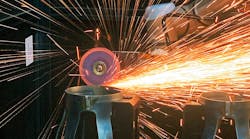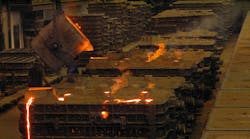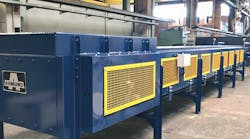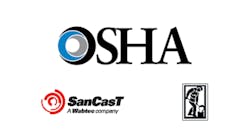The U.S. Department of Labor's Occupational Safety and Health Administration issued a total of 17 citations to SanCasT Inc., in Coshocton, OH, for serious and repeat violations found during a November 2013 plant safety inspection, and found workers exposed to amputation and fall hazards. The iron foundry had been cited previously when a worker’s leg was amputated in June 2013.
Of that incident, a local news source detailed that on June 4, 2013, a foundry worker named Davis Rhoades was trapped in an unidentified machine and had to be extricated by emergency workers. He was transported by life-flight helicopter to Columbus — a distance of about 75 miles. It was the first lost-time injury accident at the foundry in nearly a decade.
According to OSHA’s statement, the violations carry total proposed penalties of $155,900.
The citations include 11 “serious” safety violations involving lack of lockout/tagout procedures, exposing workers to struck-by hazards and failing to maintain an overhead trolley system.
Also, OSHA determined the company failed to inspect cranes and hoists regularly, and broken crane wires were discovered.
OSHA’s terminology identifies a “serious” hazard as one from which death or serious physical harm may result, and which an employer knew or should have known exists.
In addition, OSHA cited SanCasT with repeat violations for failing to protect employees from the ingoing nip points of belts, pulleys, chains and sprockets; and, for failing to protect employees from fall hazards associated with an unguarded platform. OSHA issues repeat violations when an employer has been cited previously for the same or a similar violation. SanCasT had been cited for these violations in both March and September 2013.
"SanCasT continues to demonstrate a complete disregard for the health and safety of its workers by failing to correct known hazards," stated Deborah Zubaty, OSHA's area director in Columbus, OH. "These hazards expose workers to potential lacerations and amputation injuries daily. No one should be risking injury on a job because their employer consistently fails to follow safety practices."
SanCasT is an operating unit of Standard Car Truck Co., which manufactures ride stabilization freight car truck components for railcar and locomotive producers. Some of its products include brake shoes, friction castings, wear plates of various types, wheel chocks, and many others.
Standard Car Truck is a subsidiary of Wabtec.
OSHA noted it has inspected the SanCasT operation five times since 2009.
As in all OSHA citations, the company was allowed 15 business days to comply with the terms of the citation, request an informal conference with OSHA's area director, or contest the findings before the independent Occupational Safety and Health Review Commission.









